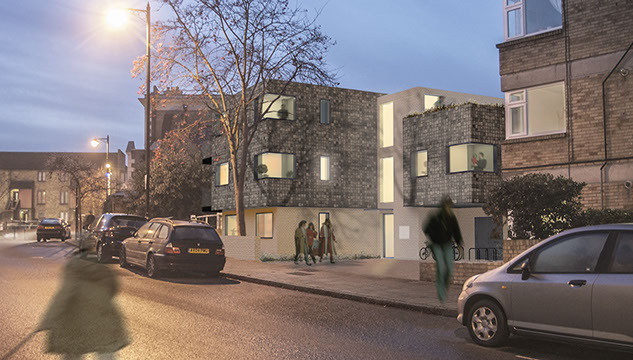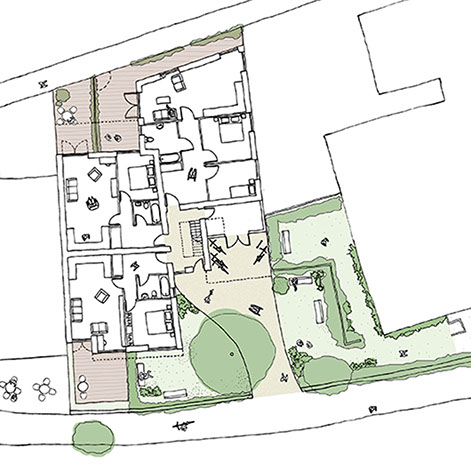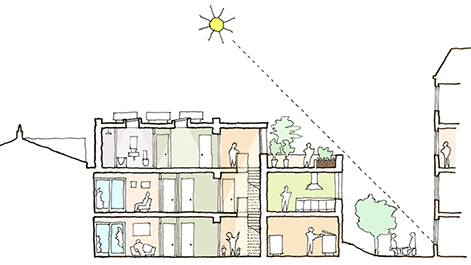Concept visualisation
Adjacent to an existing Peabody building, this development responds sensitively to its surroundings while bringing exciting contemporary architecture to the area.

Housing
Palmer Garages
Palmer Garages
Islington, London
Foreword
This proposal for eight new homes in London was part of LGA’s winning bid for Peabody’s Small Projects Panel, encouraging the housing association to select us from more than 300 architects.
Our competition-winning proposal for new homes at Palmer Garages near Archway in north London netted us a place on Peabody’s acclaimed design framework. The masterplan features eight generous, easily maintained and adaptable flats – including one wheelchair accessible home – along with high levels of public and private amenity and lots of greenery. Setting the building back from the street produces a large communal front garden, while deeply recessed, sheltered loggia balconies encourage residents to use the terraces as outdoor rooms.
The flats, which meet the requirements of the London Housing Design Guide and Lifetime Homes, are arranged around a central circulation core with a large, open stairwell that encourages informal interactions and brings light flooding into the building.
Materials were chosen for durability – and to delight – with a brick-clad ground floor topped by two timber-clad storeys. All homes are designed to achieve the Code for Sustainable Homes Level 4.
Design excellence

Nestled between the much-loved St. John’s Tavern public house to the west, and existing Peabody housing to the east, our proposal responds dynamically to its neighbours as well as to the street and wider area.
Maximising massing potential, the main entrance is at the lowest corner of the site, on St. John’s Grove. This arrangement also allows the entrance to engage with the existing Peabody homes, and distances it from the pub garden.
Setting the building back from the street creates a large front courtyard – made even bigger by removing the boundary with the adjacent Peabody block, providing a shared garden. To prevent daylighting issues the building steps up towards the west away from the neighbouring Peabody block.
Generously apartments are arranged around a central circulation core with a large open stairwell designed to encourage informal interactions between neighbours. A wheelchair accessible flat on the ground floor is provided with an alternative exit onto Brookside Road, closer to Archway town centre and giving the occupant greater flexibility.
The building is designed to facilitate speed of construction, minimising disruption to the community.
Sustainability

The homes are designed and specified to achieve Level 4 of the Code for Sustainable Homes. As part of an energy-efficient design, the building uses the maximum insulation (300mm gives an excellent U-Value of 0.08), uses framed construction, is airtight (but not too airtight, unless the building incorporates MVHR), features excellent glazing specification, high-efficiency boilers, and user-friendly smart controls that are simple enough for any householder to easily understand and control them. The design’s low embodied energy is achieved through use of the Green Guide to Specification. The scheme features PV panels, the number required reduced by the building envelope’s sustainable design and fabrication.
Construction materials are chosen for their durability, low-maintenance and ability to patinate attractively with age. We select natural materials where possible, such as brick, wood, zinc and reconstituted stone, with careful attention paid to detailing both in common areas and in the individual unit design.
The building design responds to the tough urban context to provides a safe and humane environment for families, creating dwellings that are loved and cared for by a strong community proud to call them home.
Related
SUBSCRIBE
Click below to subscribe to our newsletter or to manage your preferences
Subscribe to our newsletter
© 2020 Lyndon Goode Architects Ltd






